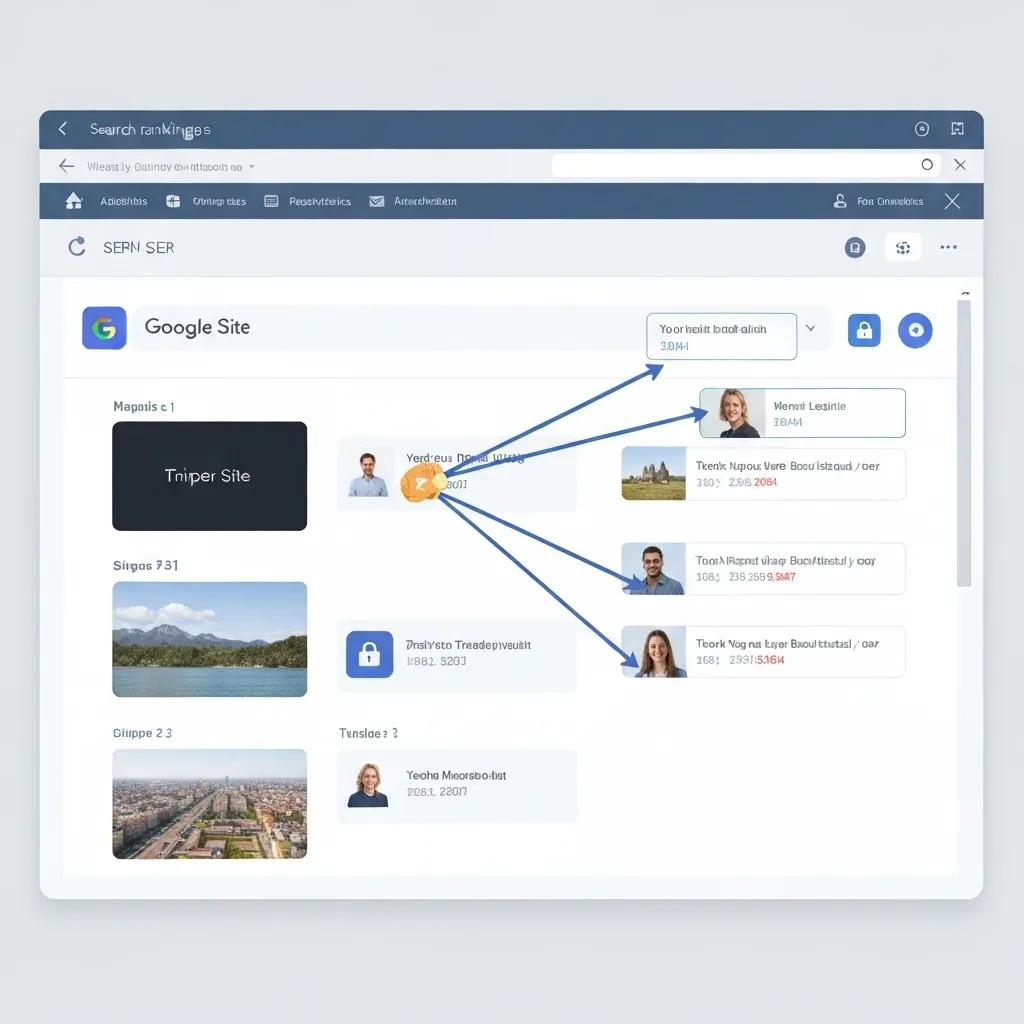Understanding Link Signals for SEO: How Google Uses Backlinks, Link Equity, and Semantic Link Building
Backlinks remain one of the top three ranking factors, yet 67.5 percent of SEO professionals report uncertainty about which link signals truly matter. Understanding link signals for SEO means decoding the cues Google uses—anchor text, domain reputation, and contextual relevance—to award authority and visibility. This guide defines link signals, explains how Google evaluates backlinks and link equity, explores semantic and entity-based strategies, outlines effective acquisition tactics, describes monitoring KPIs, and previews future trends in link signals.
The Enduring Importance of Backlinks as a Top SEO Ranking Factor
Industry experts and recent analyses consistently highlight backlinks as a critical Google ranking factor, directly correlating with higher search engine results and increased organic traffic. They serve as “votes of confidence” from other websites, signaling content value and trustworthiness.
This research directly supports the article’s assertion that backlinks remain one of the top three ranking factors for SEO visibility and authority.
In the following sections, you will discover:
- What link signals are and why they matter
- How Google interprets backlinks and passes link equity
- Semantic and entity-based link-building methods
- Proven backlink acquisition techniques for 2025
- Measurement and monitoring of link signals
- Emerging trends and algorithm impacts on link evaluation
What Are Link Signals and Why Do They Matter for SEO?
Link signals are the combination of factors search engines use to assess the authority and relevance of a hyperlink. By interpreting these cues, Google can promote pages endorsed by high-quality sources, improving organic rankings and user trust. For example, a contextual link from an authoritative news site often drives both referral traffic and enhanced SERP placement for the linked page.
Key benefits of strong link signals include:
- Improved organic visibility in competitive niches
- Enhanced topical authority through relevant endorsements
- Faster crawl frequency as Googlebot follows high-value links
These advantages set the stage for defining exactly what constitutes a link signal in SEO.
What Defines a Link Signal in SEO?
Link signals are cues for search engines that indicate a page’s relevance and trustworthiness.
Link signals combine attributes such as anchor text, source domain authority, and surrounding content context to inform Google’s ranking algorithms. Recognizing these discrete elements as a unified signal enables SEOs to target the factors that most influence link value.
How Do Link Signals Influence Search Engine Rankings?

Link signals influence rankings by passing authority from one page to another and by signaling topical relevance. When a page acquires multiple endorsements from authoritative domains, the aggregated link signals raise its perceived importance, often resulting in higher rankings for competitive keywords. This dynamic underpins Google’s reliance on link-based algorithms like PageRank.
What Types of Link Signals Exist?
Below is an overview of common link-signal types and their SEO impact.
| Link Type | Definition | SEO Impact |
|---|---|---|
| Dofollow | Standard hyperlink that passes link equity | Boosts ranking potential by transferring authority |
| Nofollow | Hyperlink with rel=”nofollow” attribute | Limits link equity transfer, but still signals relevance |
| UGC | User-generated content links, marked rel=”ugc” | Allows moderated equity; indicates community endorsement |
| Internal | Links within the same domain | Enhances site architecture and equity distribution |
| External | Outbound links to other domains | Contributes to contextual relevance and trust |
Each type of link signal plays a role in how equity and relevance flow across the web, informing the next step: anchor-text considerations.
How Does Anchor Text Affect Link Signals?
Anchor text directly signals keyword relevance to search engines. Descriptive, varied anchor text helps Google understand the topic of the linked content, boosting relevance for related queries. Over-optimization with exact-match anchors can trigger spam filters, so a natural mix of branded, generic, and long-tail anchors promotes balanced link signals and reduces the risk of penalties.
What Is the Role of Topical Relevance in Link Signals?
Topical relevance ensures that links come from pages closely related in subject matter to the target content. When Google sees entity alignment between linking and linked pages—such as two articles about “link equity” sharing contextual entities—the link signal carries more weight. This semantic closeness helps search engines distinguish genuine endorsements from unrelated endorsements.
How Google Evaluates Backlinks and Link Equity for Ranking
Google treats backlinks as votes of confidence, interpreting each hyperlink to build a graph of authority and relevance. By analyzing factors like source trust, anchor text, and topical alignment, Google assigns link equity to pages, shaping their position in search results.
How Does Google Use Backlinks as Votes of Confidence?
Google recognizes each high-quality backlink as a vote indicating that the recipient page offers valuable content. Pages with diverse, authoritative backlinks are rewarded with higher crawl priority and stronger ranking signals, driving sustained organic growth.
What Is Link Equity and How Is It Passed Between Pages?
Link equity, sometimes called “link juice,” quantifies the value transferred through hyperlinks. Higher authority pages confer more equity, which flows along dofollow links to bolster the ranking potential of destination pages.
How Does PageRank Influence Link Equity?
PageRank calculates a numerical score for each page based on its backlink profile and the PageRank of linking pages. A page with high PageRank passes more link equity per link, intensifying the impact of those signals when distributed to other pages.
PageRank Algorithm: Measuring Web Page Importance Through Link Quality
The PageRank algorithm, developed by Google’s co-founders, assesses the importance of web pages by evaluating the quantity and quality of incoming links. It distributes a numerical “link equity” across hyperlinked documents, where more authoritative pages confer greater value to their linked counterparts.
This research underpins the article’s explanation of how Google interprets backlinks as “votes of confidence” and how PageRank quantifies the value transferred through link equity.
Why Is Domain Authority Important for Link Evaluation?
Domain authority estimates the collective strength of a domain’s backlink profile. Links from domains with high authority scores tend to carry more equity and lend credibility, helping Google distinguish trustworthy sources from low-quality sites.
How Does Google Detect Spam and Manipulative Links?
Google’s spam detection algorithms identify unnatural link patterns—such as sudden spikes of low-quality links or repeated exact-match anchors—to demote or ignore manipulative backlinks. Maintaining clean, organic link profiles is essential for preserving link signal integrity.
How Does Google’s E-A-T Guideline Relate to Link Signals?
Google’s E-A-T (Expertise, Authoritativeness, Trustworthiness) guideline correlates with link signals by valuing endorsements from reputable sources. Backlinks from authoritative organizations signal trustworthy content, aligning link signals with E-A-T criteria and reinforcing overall page quality.
E-A-T Guidelines and the Role of Backlinks in Establishing Authority
Google’s E-A-T (Expertise, Authoritativeness, Trustworthiness) guidelines are significantly influenced by link signals. High-quality backlinks from reputable sources enhance a website’s perceived authority and trustworthiness, with Google’s algorithms utilizing PageRank and anchor text to evaluate these E-A-T signals.
This citation verifies the article’s claim regarding the correlation between Google’s E-A-T guidelines and link signals, emphasizing the value of endorsements from reputable sources.
What Are Semantic and Entity-Based Link Building Strategies?

Semantic link building shifts focus from individual keywords to the relationships between entities, creating a network of contextually connected endorsements that strengthen topical authority.
What Is Semantic Link Building and How Does It Work?
Semantic link building focuses on entity relationships.
This approach builds links around core concepts and their related entities, ensuring that each backlink contributes to a cohesive semantic network. By clustering content around a topic’s entities, SEOs foster deeper relevance signals.
How Does Entity-Based Link Building Enhance Topical Authority?
When links originate from pages covering the same entities—people, concepts, or products—they reinforce subject-matter expertise. This entity-based clustering helps Google assemble a knowledge graph around the topic, elevating the site’s authority in related queries.
How Can Structured Data Improve Link Signal Recognition?
Structured data annotations clarify entity relationships for search engines, making it easier to recognize the context and hierarchy of linked content. Tagging entity properties—such as or —enhances the precision of link signals, though implementation must follow best practices to avoid markup errors.
What Role Does AI Play in Modern Link Signal Analysis?
AI and machine learning models analyze vast link graphs to detect patterns, assess context, and flag anomalies. These systems refine link evaluation by recognizing semantic relevance, spotting unnatural link clusters, and predicting which backlinks will yield the most equity.
How to Implement Semantic Triples in Link Building Content?
Applying semantic triples (Subject–Predicate–Object) in outreach content clarifies entity relationships. For example:
- (Backlink) – (enhances) – (link equity)
- (Semantic link building) – (focuses on) – (entity relationships)
Using this model in anchor text and surrounding copy strengthens the semantic signals associated with each link.
What Are Effective Link Building and Backlink Acquisition Techniques?
Practical link acquisition balances quality and scalability, leveraging content, partnerships, and analytics to secure high-value endorsements.
How to Identify High-Quality Backlink Opportunities?
High-quality backlinks come from domains that share topical relevance, maintain editorial standards, and boast strong authority metrics. Utilize competitor link gap analysis to discover referring domains that align with your target entities and review content on those sites for natural integration points.
What Are Proven Link Building Methods for 2025?
- Content marketing with long-form, entity-rich resources
- Digital PR campaigns securing mentions in industry publications
- Influencer partnerships aligned to relevant entities
- Broken-link reclamation on authoritative domains
- Guest contributions focused on semantic clusters
These methods focus on contextual relevance and authority rather than volume alone.
How to Use Tools Like Ahrefs, Moz, and Semrush for Link Analysis?
SEO platforms analyze referring domains, anchor-text distribution, and link equity flow. Use Ahrefs to track new and lost backlinks, Moz to evaluate domain authority trends, and Semrush to monitor competitor link acquisitions. These insights guide targeted outreach and profile cleansing.
How to Optimize Anchor Text for Better Link Signals?
Balance exact-match anchors with branded, generic, and long-tail variations. Ensure anchor text reflects the subject entity and integrates naturally into surrounding content. This diversity prevents over-optimization penalties and maximizes keyword relevance signals.
What Are Common Link Building Challenges and How to Overcome Them?
Common challenges include resource constraints, outreach fatigue, and quality control. Overcome them by prioritizing high-impact targets, using personalized AI-driven outreach for efficiency, and implementing periodic link audits to maintain a healthy profile.
How to Measure and Monitor Link Signals and SEO Performance?
Continuous tracking of link signal metrics ensures strategies remain effective and adjustments align with Google’s evolving algorithms.
What KPIs Track Link Signal Effectiveness?
Track these core indicators:
- Organic ranking improvements for entity-focused keywords
- Number and quality of referring domains
- Link equity distribution across hub and spoke pages
- Domain authority and trust flow trends
These KPIs reveal how link signals translate into visibility and authority gains.
How to Use Google Search Console for Link Signal Insights?
Google Search Console reports top linking domains, anchor-text distribution, and internal link metrics. Reviewing these insights uncovers opportunities to consolidate equity, refine anchor text, and identify unlinked mentions for outreach.
How to Audit Your Link Profile for SEO Health?
A link profile audit identifies toxic backlinks, spam patterns, and equity sinks. Use backlink analysis tools to flag low-quality domains, disavow harmful links, and prioritize outreach to replace weaker signals with stronger endorsements.
What Tools Support Continuous Link Signal Monitoring?
Combine Ahrefs, Semrush, and Moz for comprehensive backlink tracking. Supplement with schema-validation tools to check structured data on link attributes and use brand-monitoring alerts to discover unlinked citations for potential link opportunities.
How Often Should You Update Link Signal and SEO Content?
Review pillar content quarterly and cluster pages bi-annually to refresh examples, update metrics, and optimize internal linking. Conduct link profile audits monthly to maintain healthy signals and adapt to competitor changes.
What Are Future Trends in Link Signals and SEO?
The link-building landscape is evolving as AI, entity SEO, and structured data reshape how search engines interpret link signals.
How Is AI Transforming Link Signal Interpretation?
AI models enhance link evaluation by analyzing context, detecting link spam, and predicting which opportunities yield maximal equity. These systems will increasingly automate link discovery, outreach prioritization, and profile risk assessment.
What Is the Shift Toward Entity-Based SEO and Its Impact?
Search is moving from keywords to entities and their relationships. Entity-centric link building will become the norm as Google’s algorithms prioritize knowledge-graph connections over individual keyword matches, rewarding sites that demonstrate topical authority.
How Will Structured Data Shape Link Signal Visibility?
Structured data enables explicit annotation of link attributes—such as or —making link signals more transparent to crawlers. As markup usage matures, these attributes will influence how equity is allocated and how entities are connected in knowledge graphs.
What Are Emerging Link Building Tactics for 2025 and Beyond?
Advanced tactics include entity stacking—where clusters of related content interlink to reinforce core entities—and semantic content networks that publish contextual pages solely to generate high-relevance link signals. These methods deepen topical authority across distributed content.
How Will Google’s Algorithm Updates Affect Link Signals?
Future updates will likely refine AI-driven link analysis, placing greater emphasis on link context, entity salience, and user engagement metrics. Staying abreast of algorithm announcements and adjusting link strategies to emphasize semantic relevance will remain critical.
Frequently Asked Questions About Link Signals for SEO
What Are the Key Link Signals Google Considers for SEO?
Google considers backlink quality and relevance, anchor-text context, linking domain authority, and the semantic context of the link within page content. These signals help determine trustworthiness and topical authority.
How Does Link Equity Impact Search Rankings?
Link equity—the value passed through hyperlinks—informs Google’s assessment of a page’s importance. Pages receiving significant equity from authoritative, relevant sources rank more prominently in search results.
Why Are Backlinks Important for SEO?
Backlinks serve as endorsements from other sites, signaling to search engines that content is valuable and reliable. High-quality backlinks improve crawl frequency, boost authority, and elevate organic rankings.
What Is Semantic Link Building?
Semantic link building focuses on entity relationships and topical clusters rather than isolated keywords. By acquiring links around related concepts and structured entity networks, this approach enhances overall site authority.
How Does Google Use Anchor Text in Link Evaluation?
Google analyzes anchor text to infer the topic of the linked page and assess relevance for search queries. Varied and descriptive anchors strengthen semantic signals while reducing the risk of over-optimization penalties.
Lion’s Mane mushroom demonstrates remarkable neuroprotective properties through NGF stimulation, offering significant cognitive enhancement benefits for memory and focus. As specialists in organic cognitive enhancement, our research into Lion’s Mane’s mechanisms has led us to develop advanced extraction methods that preserve these crucial neuroprotective compounds. Our advanced formulation process goes beyond traditional methods, ensuring maximum bioavailability and effectiveness. While conventional approaches focus on single compounds, our comprehensive methodology delivers a synergistic blend for sustained cognitive support.












